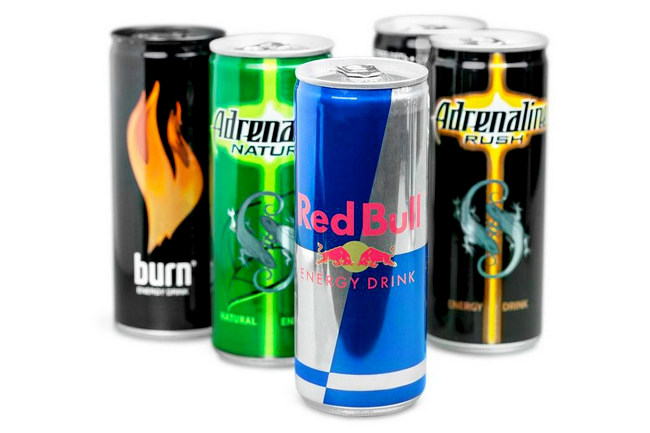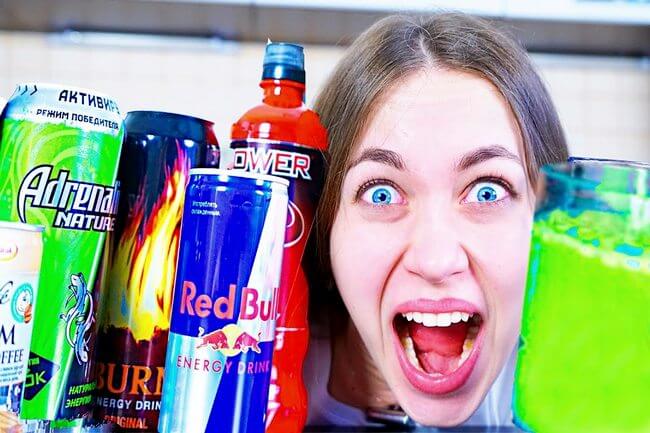The drinks of the third millennium – that’s how energy drinks are called, and they are very popular. Students who cram for exams at night; young people who hang out in clubs; truck drivers, guards, cleaners, and other shift workers; those who need to do a workout after a hard working day – the list of their consumers is far from complete.
Despite the fact that the media often scare us with the harmful effects of energy drinks to the human body, they still remain sales leaders. So what is more in them – benefit or harm?
General Information

Energy drinks are soft drinks with a pronounced tonic, anti-sedative effect due to the content of natural psychostimulants. They are recommended for quick recovery, to relieve fatigue and drowsiness. They are mostly consumed by those who need to stay awake or double their activity for several hours.
Many people think that this is the discovery of the 21st century, but this is not true. Their predecessors can be found in the works of medieval herbalists. In particular, one of the books of the famous German abbess Hildegard von Bingen (12th century) contains a recipe for a potion that gives vitality.
They appeared in a form that we know now a century ago. In 1927, in Great Britain, Lucozade was created to accelerate the recovery of the sick. Its composition was typical for modern energy drinks: carbon dioxide, glucose syrup, citric and lactic acids, caffeine, sodium benzoate and bisulfate, vitamin B9.
In 1962, on its basis, a new drink Lipovitan was created in Japan, which began to be sold not as a medicine for rapid recovery, but as a stimulating drink that doesn’t let you fall asleep for several hours, giving a boost of energy and vivacity. Since then, the production of energy drinks in the East has been put on stream.
In Europe, the start was given by Austrian entrepreneur Dietrich Mateschitz, who borrowed the recipe during a vacation in Hong Kong. Having supplemented it with more modern and perfect components, he created a new product Red Bull, which eventually made him one of the richest people on the planet. The brand has a scandalous reputation, but still enjoys incredible popularity all over the world.
In 1985, energy drinks conquered America thanks to Jolt Cola, which was recommended for students and people of professions that require prolonged mental and physical exertion. In 1995, it was replaced by Josta from PepsiCo, on the basis of which Adrenaline Rush has been produced since 1999.
In New Zealand and Australia, the sales leaders are drinks from Frucor Beverages.
Today, sales exceed $50 billion.
Many people are interested in the question: at what age are energy drinks sold? If they do not contain alcohol, in the territory of the Russian Federation they can be freely sold to people of any age, including children and teenagers. The law does not prohibit this. The exception is the Moscow region, where since May 1, 2015 such drinks have been banned for sale to minors.
Effects on the Body
Since the start of mass production of energy drinks, the debate about their effects on human health has never subsided. In order to understand what is more in them – benefit or harm – it is necessary to figure out which systems and organs they affect, and how exactly.
Properties:
- tonic – they increase vitality, ensuring a state of prolonged excitation of the nervous system and muscle tissue without fatigue;
- central nervous system stimulation – they cause its increased activity, accelerate work;
- anti-sedative – invigorating, relieving drowsiness and apathy, preventing falling asleep.

Due to these properties, within 2-4 hours after taking the drink (the duration of the effect depends on the individual characteristics of the organism):
- the mood rises sharply, up to a state of euphoria;
- there is a surge of strength, cheerfulness, energy;
- there is no desire to sleep;
- work capacity increases;
- strength and endurance increase;
- thought processes are activated;
- the desire for motor activity increases.
A person feels all this within 5-10 minutes after taking. However, the coin has another, not so obvious side.
It seems to everyone that energy drinks themselves are a source of energy. This is not true. The active substances included in their composition are stimulants that work on a simple scheme: they are quickly absorbed into the blood, excite the nervous system, forcing the body to spend its own energy in a double dose and only then distribute it to the cells. That is, they do not supply it, but take it in large quantities from the person himself.
An example for clarity and comparison. A mover needs to unload 4 cars during an 8-hour working day. He can do this by evenly distributing the load – 1 car in 2 hours. In this case, he will take breaks for rest and at the end will feel only slight fatigue. But he can do otherwise: unload all 4 cars in 2 hours, working at an accelerated pace, without regaining his strength. As a result, he will exhaust all reserves of his body and by the end of the second hour will feel unwell.
The same thing happens with the body, which in a normal state evenly distributes the available energy. Energy drinks force it to use everything in a short period of time. It is not difficult to guess what will happen after the effect ends: exhaustion, loss of strength, feeling unwell, and this is not the whole range of sensations that you will have to experience after euphoria.
Thus, the effect of energy drinks on the human body is a vivid illustration of a double-edged sword. On the one hand, it is a surge of strength and an incredible surge of energy when you feel that you can move mountains. However, behind this is the complete exhaustion of the body and nervous system in a few hours.
Composition
The effect of energy drinks on the body is determined by the active substances that make up their composition. The base is almost the same for all brands with minor variations.
Main active ingredients:
- glucose – the main “fuel” for the body;
- taurine – an amino acid that accelerates energy processes in the body;
- caffeine – an alkaloid psychostimulant that stimulates the central nervous system and heart activity, increases the heart rate, causes vasodilation, increases intellectual and physical performance, and eliminates drowsiness;
- guarana – a plant, the extract of which contains a large amount of caffeine, improves mood, and invigorates;
- ginseng – a natural psychostimulant;
- nicotinic acid (vitamin B3) stabilizes the nervous system;
- pantothenic acid (B5) is involved in the restoration of nerve tissues;
- pyridoxine (B6) has a regulating effect on the nervous system;
- folic acid (B9) increases the production of serotonin and norepinephrine in the body, which improve mood;
- ascorbic acid (C) ensures the delivery of glucose to the point of consumption, participates in the production of serotonin.
This does not count preservatives, dyes, and carbonic acid, which makes them carbonated. The presence of caffeine and glucose is a must. Taurine is found in 75% of drinks.
At first glance, the composition may seem balanced: some substances stimulate the nervous system, others soothe and stabilize it. In fact, there are several times more of the former than the latter. Manufacturers use only 1-2 vitamins, and in minimal quantities.
Harm
Why does the media constantly talk about the fact that energy drinks are harmful? For some time (2009-2010), Red Bull was banned in several countries due to the fact that it was allegedly found to contain cocaine elements. A later examination refuted this fact, but caused a surge of indignation and protests.



